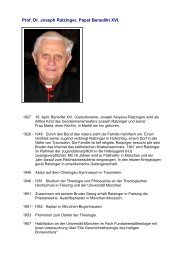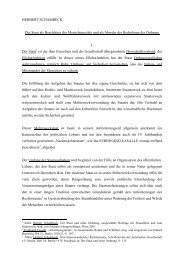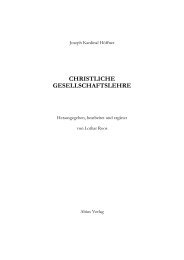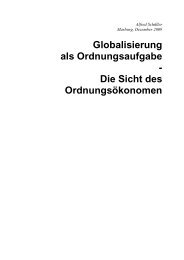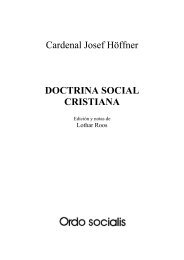Joseph Cardinal Höffner CHRISTIAN SOCIAL ... - Ordo Socialis
Joseph Cardinal Höffner CHRISTIAN SOCIAL ... - Ordo Socialis
Joseph Cardinal Höffner CHRISTIAN SOCIAL ... - Ordo Socialis
Create successful ePaper yourself
Turn your PDF publications into a flip-book with our unique Google optimized e-Paper software.
structure and life of society. Seneca taught that „we are members of one great body“, since<br />
nature has generated us as „relatives“ and made us „social beings.“ 14 Thomas Aquinas systematically<br />
incorporated the organism analogy into his social teaching: society is „reputed as<br />
one body“ and „as one man“(I-II,81,1). A contemporary of Aquinas, Vincent de Bovais,<br />
called the state a ‘mystical body’ (corpus politicum mysticum), a designation which, in the<br />
fifteenth and sixteenth centuries, was taken up by Johannes Gerson, Antonius de Rosselis,<br />
Domingo de Soto, and Francisco Suarez. St. Paul also applied the organism analogy to the<br />
Church. He speaks of the „Body of Christ“ in a double sense: in some places, ‘Body of<br />
Christ’ means the Church as a visible, organically articulated, social phenomenon (1 Cor<br />
12:12-30; Rom 12:4-8); in other places by ‘Body of Christ’ Paul understands the supernatural,<br />
mysterious community of life and grace that binds the members together with their head and<br />
with one another (e.g. 5:21). The expression ‘mystical body’ is not employed by Paul; it first<br />
emerges in early scholasticism and, as we have seen, has been applied from the thirteenth century<br />
on not only to the Church, but also to the state.<br />
2. Christian social philosophy makes use of the organism analogy in order to reject the individualistic<br />
conception of society, on the one hand, and to elucidate the common-good principle,<br />
on the other. Here three kinds of analogies can be distinguished:<br />
a) Organisms continue to exist, whereas the individual cells pass away and are built up anew<br />
again and again. In an analogous way, society outlasts the coming and going of individual<br />
people. Even the family spans two generations. Village and city, nation and state exist for<br />
centuries. Society, Augustine writes in the twenty-second chapter of the City of God, is like<br />
an olive tree whose leaves fall and grow forth anew, but whose trunk and crown remain. The<br />
organism analogy thus makes clear, on the one hand, that society temporally transcends the<br />
short span of human life, reaching in the past and the future, and is thus not a static quantity,<br />
but is filled with an urgent and often tempestuous movement; on the other hand, it also spatially<br />
surpasses the living space of the individual, like the branches of the olive tree.<br />
b) The parts of an organism, such as the leaves and roots of a plant, do not form a sum of unrelated<br />
individual things; they are rather placed in the service of the whole by the immanent<br />
vital force of the entelechy. One can again see this mode of being realized in an analogous<br />
way in a society whose members are not isolated individuals, but form a spiritual and moral<br />
unit of order and serve the whole.<br />
c) Organisms do not allow their members to wither away, but nourish and preserve them; only<br />
in the most extreme need does an organism sacrifice a member in order to save the whole. a<br />
similar law holds analogously in society also, which is not allowed to exploit its members, but<br />
must care for them, whereas the members must be ready in turn to subordinate their interests<br />
selflessly to the common weal. As the hand instinctively exposes itself to the sword thrust in<br />
order to save the whole body, so the citizen will „expose himself to the danger of death for the<br />
whole body politic“ (Thomas Aquinas, I, 60,5).<br />
3. The following emerges from the organism analogy for the interpretation of the common<br />
good: it is false to see with Viktor Cathrein in the common good „nothing other than the sum<br />
of homogeneous individual welfares.“ 15 The common good is not a sum, but a new value specifically<br />
different from the individual good and the sum of individual goods. Every social entity,<br />
such as a city or a university, has its particular common good. If, however, one speaks of<br />
the common good purely and simply, the common good of the ‘perfect society’ of the state is<br />
14 L.A. Seneca ad Lucilium I, XV. ep. 4. (Bononiae 1927) 83.<br />
15 V. Cathrein, Moralphilosophie. 5th ed (Freiburg i.B. 1911), I: 284<br />
30




